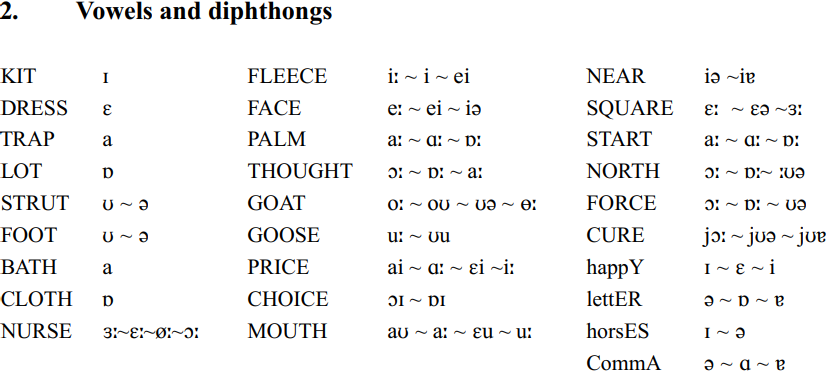

Grammar


Tenses


Present

Present Simple

Present Continuous

Present Perfect

Present Perfect Continuous


Past

Past Simple

Past Continuous

Past Perfect

Past Perfect Continuous


Future

Future Simple

Future Continuous

Future Perfect

Future Perfect Continuous


Parts Of Speech


Nouns

Countable and uncountable nouns

Verbal nouns

Singular and Plural nouns

Proper nouns

Nouns gender

Nouns definition

Concrete nouns

Abstract nouns

Common nouns

Collective nouns

Definition Of Nouns

Animate and Inanimate nouns

Nouns


Verbs

Stative and dynamic verbs

Finite and nonfinite verbs

To be verbs

Transitive and intransitive verbs

Auxiliary verbs

Modal verbs

Regular and irregular verbs

Action verbs

Verbs


Adverbs

Relative adverbs

Interrogative adverbs

Adverbs of time

Adverbs of place

Adverbs of reason

Adverbs of quantity

Adverbs of manner

Adverbs of frequency

Adverbs of affirmation

Adverbs


Adjectives

Quantitative adjective

Proper adjective

Possessive adjective

Numeral adjective

Interrogative adjective

Distributive adjective

Descriptive adjective

Demonstrative adjective


Pronouns

Subject pronoun

Relative pronoun

Reflexive pronoun

Reciprocal pronoun

Possessive pronoun

Personal pronoun

Interrogative pronoun

Indefinite pronoun

Emphatic pronoun

Distributive pronoun

Demonstrative pronoun

Pronouns


Pre Position


Preposition by function

Time preposition

Reason preposition

Possession preposition

Place preposition

Phrases preposition

Origin preposition

Measure preposition

Direction preposition

Contrast preposition

Agent preposition


Preposition by construction

Simple preposition

Phrase preposition

Double preposition

Compound preposition

prepositions


Conjunctions

Subordinating conjunction

Correlative conjunction

Coordinating conjunction

Conjunctive adverbs

conjunctions


Interjections

Express calling interjection

Phrases

Sentences


Grammar Rules

Passive and Active

Preference

Requests and offers

wishes

Be used to

Some and any

Could have done

Describing people

Giving advices

Possession

Comparative and superlative

Giving Reason

Making Suggestions

Apologizing

Forming questions

Since and for

Directions

Obligation

Adverbials

invitation

Articles

Imaginary condition

Zero conditional

First conditional

Second conditional

Third conditional

Reported speech

Demonstratives

Determiners


Linguistics

Phonetics

Phonology

Linguistics fields

Syntax

Morphology

Semantics

pragmatics

History

Writing

Grammar

Phonetics and Phonology

Semiotics


Reading Comprehension

Elementary

Intermediate

Advanced


Teaching Methods

Teaching Strategies

Assessment
Differences between dialects in the North of England
المؤلف:
Joan Beal
المصدر:
A Handbook Of Varieties Of English Phonology
الجزء والصفحة:
120-6
2024-02-24
1478
Differences between dialects in the North of England
According to Wells (1982), “local differences in dialect and accent as one moves from valley to valley or from village to village are sharper in the north than in any other part of England, and become sharper the further north one goes” (Wells 1982: 351). In the light of recent studies which provide evidence of levelling in the North of England (discussed in 1.2 above), this may seem too bold a statement. Nevertheless, it is certainly the case that, even with regard to modern dialects, more features differentiate northern dialects from each other than are common to all of them. Even in areas where levelling occurs, new shibboleths are emerging to represent perceived differences between speakers living as little as 10 miles apart (cf. Beal [2000a] for an account of differences between ‘Geordie’ [Newcastle] and ‘Mackem’ [Sunderland]).
Whilst all northern dialects share certain phonological features, notably the short /a/ in BATH and ‘unsplit’ /u/ in FOOT/ STRUT, others differentiate dialects within the North. Some of these distinctions are not strictly geographical, except insofar as they distinguish the more traditional speakers in rural areas from their urban neighbors. Even in the most remote corners of England today, young people attend high school and carry out leisure pursuits in larger towns and cities, so speakers of traditional dialects are likely to be older as well as rural. An example of a distinctive feature of traditional dialect can be found in the North-east, where increasingly only traditional dialect speakers have the Northumbrian burr  . However, other North-eastern features, such as /h/- retention, would be common to all speakers in this area, at least north of the Wear.
. However, other North-eastern features, such as /h/- retention, would be common to all speakers in this area, at least north of the Wear.
Other features distinguish dialect areas within the North from each other. In Trudgill’s account (1999: 65–75), the area which I have defined as the North in 1.1. above includes six dialect areas: Northeast, lower North, central Lancashire, Merseyside, Humberside and Northwest Midlands (the last of these includes Manchester). These divisions are arrived at on the basis of five phonological criteria: /h/-dropping/retention, monophthong versus diphthong in FACE, velar nasal plus in SING, rhoticity versus non-rhoticity, and the final vowel of happY. As we shall see, whilst these features do serve to distinguish the major dialect divisions in the North of England, they are not the only features which are salient.

 الاكثر قراءة في Phonology
الاكثر قراءة في Phonology
 اخر الاخبار
اخر الاخبار
اخبار العتبة العباسية المقدسة

الآخبار الصحية















 قسم الشؤون الفكرية يصدر كتاباً يوثق تاريخ السدانة في العتبة العباسية المقدسة
قسم الشؤون الفكرية يصدر كتاباً يوثق تاريخ السدانة في العتبة العباسية المقدسة "المهمة".. إصدار قصصي يوثّق القصص الفائزة في مسابقة فتوى الدفاع المقدسة للقصة القصيرة
"المهمة".. إصدار قصصي يوثّق القصص الفائزة في مسابقة فتوى الدفاع المقدسة للقصة القصيرة (نوافذ).. إصدار أدبي يوثق القصص الفائزة في مسابقة الإمام العسكري (عليه السلام)
(نوافذ).. إصدار أدبي يوثق القصص الفائزة في مسابقة الإمام العسكري (عليه السلام)


















